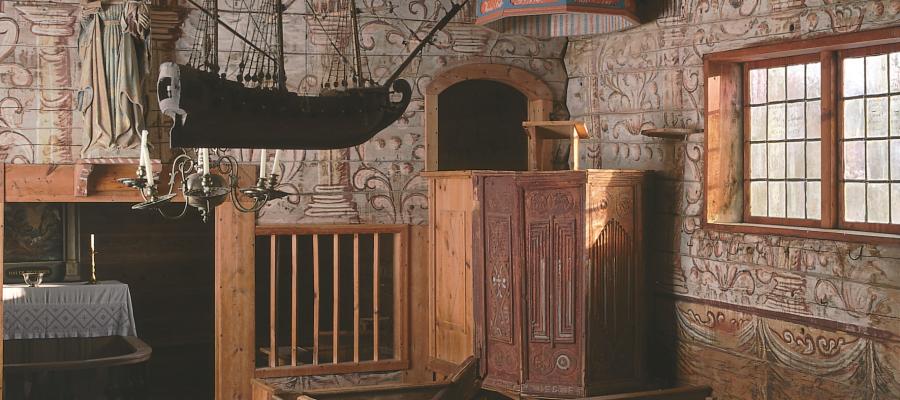The frontal from the old stave church in Ulvik is one of the finest examples of English influenced Gothic to be found anywhere in Europe. Beside the Crowned Jesus in the central panel we see Peter, Paul and Andrew, amongst others. (Ann-Mari Olsen, owner: Bergen University museum (MA 3)).
Church Art – a Message in Pictures
In the still and dim church interiors of the Middle Ages the performances of belief came to life in the gleam from the wax candles. Beautiful and significant pictorial imagery rose up in front of the congregation’s eyes from the frontals on the front of the altar table. The attention of the congregation was focussed on the pictures on the altar. Here the essential articles of faith were presented, here the church was presented through holy men and holy women and here the events from the Gospels were told: the angels with Maria, the birth of the baby Jesus, the Three Wise Men, the history of the drama of the Passion and the victorious Christ.
These images constituted the congregation’s bible in a time when only a few could read. Today we do not find the frontals in their old place in the churches. As inalienable treasures they are to be found, together with much other medieval ecclesiastical art, in the Historical Museum (HM), at the University of Bergen. The Museum’s first vice-director, from 1825 to 1848 was Bishop Neumann of Bergen who on his many visitations had a watchful eye open for threatened ecclesiastical possessions! The frontals are unique in European art history, but they are part of a long tradition where each age has portrayed the world of belief in its own way; a tradition of a thousand years from today and right back to the time when Christianity came to the country.
The earliest Romanesque sculptures are strictly frontal (one-dimensional). The triumphant Crucifix from Jondal Church from around 1200 AD bears the first traces of the change from the Romanesque “Christ as the Victorious King” to the Gothic: “Christ the suffering son of God”. (Ann-Mari Olsen, owner: University Museum in Bergen (MA 269)).
The church in Holdhus from 1726 gives us an evocative picture of the interior of the small wooden churches which replaced many of the medieval stave churches. In the liturgy of the Reformation, the preaching of the word of the Lord was as important as a Holy Communion and the pulpit, “God’s own seat” became a central element in the interior of the church. The pulpit here is from 1570, the earliest preserved in Hordaland. (Photo: Egil Korsnes).
The late medieval altar piece from Austevoll Church probably comes from a North German or North Holland workshop. Similar altar pieces from the churches in Uggdal, Granvin, Birkeland and Eksingedalen are to be found in the Historical Museum in Bergen. (Ann-Mari Olsen, owner: University Museum in Bergen (MA 283)).





